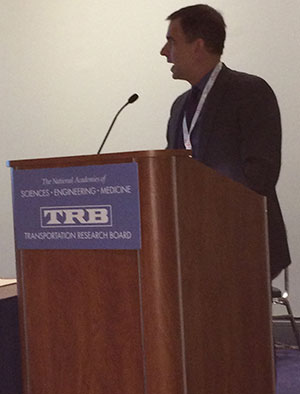Senior Reporter
P3s Not Suited for All Infrastructure Projects, US DOT Official Says
WASHINGTON — A federal transportation official reminded state and municipal agencies charged with advancing infrastructure projects of the need to review the costs and potential benefits associated with public-private partnerships.

Polston at TRB. (Eugene Mulero/Transport Topics)
While the partnerships, known as P3s, are a funding option transportation officials have at their disposal, private investors typically are drawn to corridors with high volumes of traffic.
“Not every project is suitable for a P3,” said Mark Polston, deputy director of the Build America Bureau at the U.S. Department of Transportation. “Every project has to be evaluated, whether or not a P3 is appropriate.”
Polston spoke Jan. 8 at the Transportation Research Board’s annual meeting in Washington.
P3s’ potential benefits include expedited project delivery, improved costs and schedule control and the conservation of the public sector’s debt capacity. Drawbacks include the perception that private sector firms have gained an unfair benefit and that new fees such as tolls will be imposed on drivers, Polston explained.
Critics of P3s that rely on tolls argue rural highways lack the requisite traffic volume for toll operators to generate a profit. The top Republican transportation decision-makers on Capitol Hill represent rural districts.
Trump White House officials have been touting P3s as a viable source of funding with the potential of drawing in private sector funds. A $1 trillion, 10-year infrastructure plan that President Donald Trump is expected to unveil in January will promote the use of P3s, according to details published in 2017.
Established during the Obama administration, the Build America Bureau is designed to assist local governments by facilitating access to federal grants as well as to provide guidance for financing large-scale infrastructure projects.
A common public-private partnership consists of generating capital for large projects to ensure a return on investment over time through dedicated debt payments or tolls.
States have launched P3s and tolls to advance big-scale highway projects. In Virginia, for instance, transportation officials approved a partnership to open the express lanes on the Capital Beltway, known as “hot lanes.” Florida and Texas have enacted legislation facilitating the use of P3s.
In the coming years, bridges or roads, whether public or private, would be able to be inspected through drones, researchers said at a different panel during the annual meeting. Tests are ongoing to determine whether inspections via drones would advance safety, said Basil Yap of the North Carolina Department of Transportation.
“Drone technology is quickly advancing,” Yap said. The department is scheduling workshops on the use of drones.

